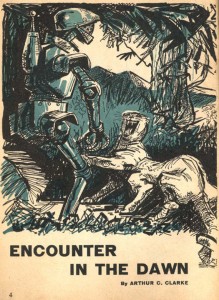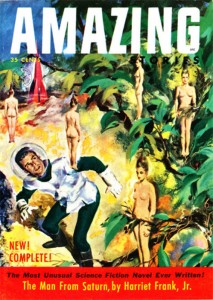The name Clarke is synonymous with pretty much everything that is science fiction. Though many fans of the genre arbitrarily link the name to the epic drama of exploration of humanity 2001: A Space Odyssey, it can be said that the story can be linked to many of his previous works. The earlier works of Arthur C. Clarke has had influence on many writers, but those earlier tomes played an influential role in Clarkes own writing.
Encounter at Dawn is one of those stories. Metaphorically, like the growth of literary ideas, the story is about the evolution of a planet and its prevailing civilization. In actuality, the story is also an example of how ideas can grow into greater, even more diabolical lines of plot than from those of the predecessor.
 The version I have comes from my handy go-to copy of “The Worlds of Arthur C. Clarke – Of Time and Stars,” a 1978 print anthology from Puffin Publishing. But like many of these Clarke short stories, they can be found in many other locations under a number of different titles. The first appearance of the story was in the June-July 1953 Amazing Stories with the variant title Encounter in the Dawn. Later that year, the story went by the title Expedition to Earth and was the eighth installment of an eleven story anthology that also went by Expedition to Earth.
The version I have comes from my handy go-to copy of “The Worlds of Arthur C. Clarke – Of Time and Stars,” a 1978 print anthology from Puffin Publishing. But like many of these Clarke short stories, they can be found in many other locations under a number of different titles. The first appearance of the story was in the June-July 1953 Amazing Stories with the variant title Encounter in the Dawn. Later that year, the story went by the title Expedition to Earth and was the eighth installment of an eleven story anthology that also went by Expedition to Earth.
What’s it all about?
A survey ship is probing the outer rim of the galaxy when they come across a terrestrial planet similar to their own world. With undisclosed tension growing back home, the three occupants of the ship know that they could be called away at any moment and impatience clouds their investigation.

from Amazing Stories
June-July 1953
interior art (uncredited)
The planet is home to a tribe of primitive humanoid lifeforms, so the survey crew must rely on a stealthy robot hiding on the outskirts of the village for initial observation. Time is of the essence and one of the crew pushes the contact by confronting one of the tribesmen hunters in the nearby wild. Though tension is high, nothing is said and both eventually turn their separate ways. Over a period of time, these meetings increase with the survey crew eventually presenting the hunter with a kill (collected by the robot) as a sign of good gesture.
Sadly, the home world beckons the crew and they must abandon their research before relations with the village can be improved. The opportunity to give these beings a boost in technological advancements is gone. The hunter believed these space travelers were gods, yet it seems that this lone world is destined to struggle with knowledge and remain forever as a primitive civilization. That is until we learn that the “descendants would build the great city they were to call Babylon.”
Arthur C. Clark used many of his shorter works as inspiration and backgrounds to other stories. Encounter at Dawn was one of the tales that was used in forming the beginning to 2001: A Space Odyssey. As a lessen to all past present and future writers, this is a brilliant tool for writing prompts, character background building, or just plain honing one’s skills. Not everyone is going to pen a Space Odyssey, but the realization that something so small has the potential to contribute to something so big should be inspiration to anyone willing to pick up a pen or keyboard.

June-July 1953 cover
One of the conundrums of writing science fiction is getting the facts right. So how do we create something that we have never seen before without going overboard to the point of absurdity. When creating a sentient being, it doesn’t always seem responsible to rely on the little green men with big eyes theory. It doesn’t always have to be hideous monsters dripping acidic blood and craving human flesh either. Sometimes, the simplest measure is a reflection of what we already know.
Clarke used this to perfection:
“Ten thousand generations lay between them, ten thousand generations and an immeasurable gulf of space. Yet they were both human. As she must do often in Eternity, Nature had repeated one of her basic patterns.”
Yes, this plays into the juxtaposition of humanity’s evolution over time as well as probability of humanity truly being alone in the universe, but it also lends realism to a story that could have seemed campy if the creatures had been green.
I also have to give a nod to a couple lines in Encounter at Dawn that made me stop. It’s a bad habit when reviewing works and probably the number one reason some stories take longer to read than others. This is not to say these lines are poorly written or are major distractions from the story. It is merely a pause of admiration from a wannabe writer and an occasional opportunity to take notes.
First is Clarke’s version of having skeletons in one’s closet, but with a science fiction twist:
“There was always a skull hidden behind Nature’s most smiling face. Wild beasts, poisonous reptiles, quagmires – death could come to the unwary explorer in a thousand disguises.”
Things are rarely as they seem, and Clarke hits the reader with plenty of warnings, but we know we won’t listen because we want to be surprised anyway. I’d like to think the smiling face is the planet and the reference to the hidden skull being the crossed paths of humanity’s past and future.
Lastly, the author uses a simple sentence to set an emotional scene as humanity leaves its past behind.
“No more swiftly than smoke drifts upward from a fire, the ship lifted away.”
What can I say? I liked the sentence and I’ve pondered it many times since, trying to figure out how to pack such vision into one line.
Encounter at Dawn went by many titles over the years, but regardless what label author Arthur C. Clarke used or intended, the story stirred some of the same questions about humanity that writers have been trying to answers for years. But at the same time, the story has also become a unique model of how those questions can be presented and it provides some fantastic ideas as to what those answers might be.










